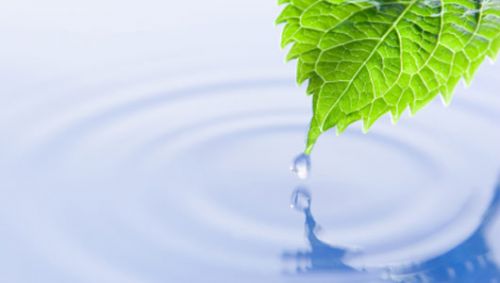Recycling greywater
Greywater
Greywater is soapy water from washbasins, showers and baths.
These waters are low loaded and not greasy (the waters from kitchen are excluded).
Thanks to our Micro-clear® recycling technology, all these waters can be used a second time.
Therefore, 50% of the needs usually provided by the city network can be satisfied by recycled water. This includes all needs that do not require drinking water (non-corporeal and non-food).
Depending on the size of the installation, recycling from 1m³ to 150m³ / day of greywater from showers and washbasins for reuse in toilets, surface washing or watering will be possible.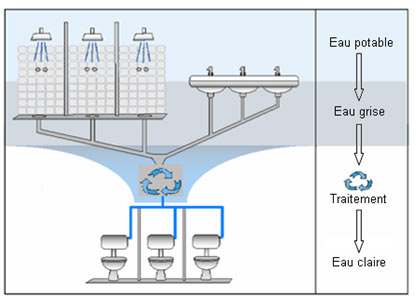
PROFITABILITY OF GREYWATER RECYCLING
Unlike other resources which are less regular, greywater has a regular volume throughout the year.
Seasonal variations in volume are usually proportional to needs.
The volumes of treated water are exempt from sanitation taxes.
The return on investment is calculated according to the size of the installation and the daily processing volume.
THE MICROCLEAR ® FILTRATION MODULE
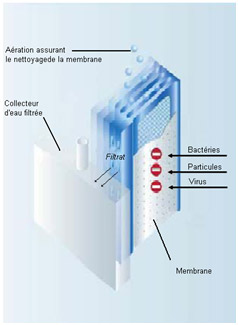
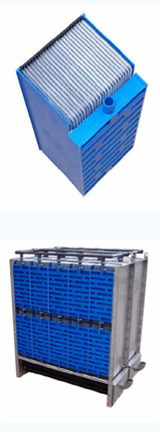 Each module is made up of 24 plastic filtration plates laser-welded to one another. The entire set represents a filtration area of 3.5 m² and is hermetically connected to a filtrate collector.
Each module is made up of 24 plastic filtration plates laser-welded to one another. The entire set represents a filtration area of 3.5 m² and is hermetically connected to a filtrate collector.
Depending on required needs, a variable number of modules are stacked and assembled in the frames of different sizes, which also support the aeration system. The latter ensures the cleaning of all membranes.
The principle: Greywater coming from an external source flows through the membrane inside the plate before being sucked towards the filtrate collector by a negative pressure of only 0,1 bar.
Thanks to the membrane pore size of 0.05 μm, particles, bacteria and even viruses are physically blocked!
Phases of treatment
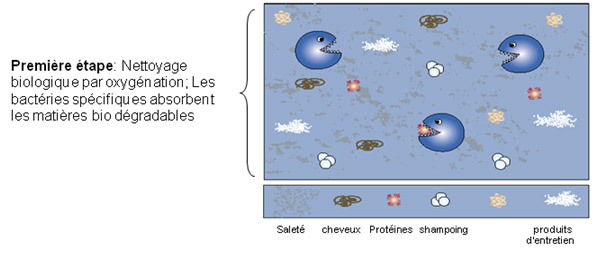
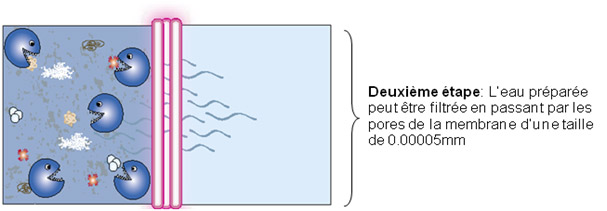

In summary, our technology combines great security regarding the quality of the filtrate obtained, and reduced maintenance regarding the cleaning of membranes (1 to 2 times per year).
IMPLEMENTATION
Depending on the project environment, several ways of implementation can be considered.
The system can be buried outside a building or integrated into a HDPE, concrete or even steel tank depending on the daily treatment volume.
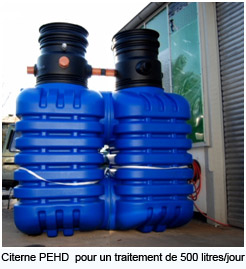
In most cases, the system is integrated into the basement of the building.
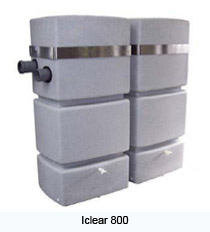
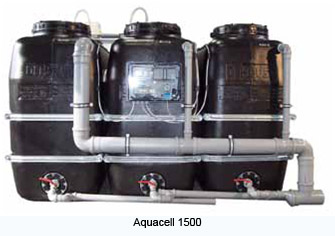



 Photovoltaic, biomass, biogas, geothermal, these green sectors are multiplying and diversifying. Do these sectors work well?
Photovoltaic, biomass, biogas, geothermal, these green sectors are multiplying and diversifying. Do these sectors work well? Aquae Environnement equips Carpe Diem tower at la Défense by ensuring the recycling of rainwater from facades and greywater from washbasins.
Aquae Environnement equips Carpe Diem tower at la Défense by ensuring the recycling of rainwater from facades and greywater from washbasins. Aquae Environnement equips the new headquarters of Bouygues TELECOM by ensuring water supply of 350 toilets on 23 levels and the supply of the system of green spaces watering!
Aquae Environnement equips the new headquarters of Bouygues TELECOM by ensuring water supply of 350 toilets on 23 levels and the supply of the system of green spaces watering! Aquae Environnement equips the new stadium of Nice with rainwater recycled from the 30,000 square meter roof to supply sanitary facilities and fire network as well as to water the lawn.
Aquae Environnement equips the new stadium of Nice with rainwater recycled from the 30,000 square meter roof to supply sanitary facilities and fire network as well as to water the lawn. Millions of cubic meters of water are wasted in France, because people have not yet form the habit of recovering rainwater.
Millions of cubic meters of water are wasted in France, because people have not yet form the habit of recovering rainwater.




